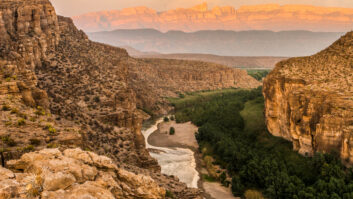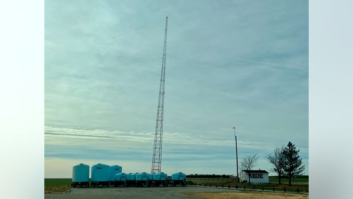The author runs International Media Action, a non-profit engineering organization that helps build community radio stations.
KCAW is a community radio station in Sitka, Alaska, a city with a population of roughly 8,500. It produces its own local newscasts, has volunteer programmers and carries NPR and public radio-syndicated programming.
It also has a network of seven translators that carry KCAW to seven nearby towns. These communities range in population from a few dozen in Elfin Cove to about 900 in Yakutat. The population grows quite a bit every summer, when thousands converge on the region to work in the commercial fishing industry.
Becky Meiers is station manager. When she took the job five years ago, she discovered that there were many people who relied on the signal as the only station they could get. However, the equipment was so decrepit that there were frequent outages of weeks. She decided to make it a station priority to update the system of repeaters and expand the reach out over the water so that the commercial fishing fleet would be able to tune in reliably.
The translators had been built in the 1980s and have not been updated much since. KCAW sends its audio feed to them by satellite.
The current transmitters are mostly crystal-controlled Crown 10-watt units. They’re sturdy and, like much equipment of that era, built as though they were intended to survive a nuclear war. But they are getting long in the tooth. The Crowns lack some features that we have come to expect in modern transmitters, such as internal audio processors, internet-based diagnostics, remote control and monitoring through a GUI.
Working in Port Alexander
Our first project was the update of the translator in Port Alexander, year-round population 56. It has no cars, no roads, no stores, no cell service, no grid electricity. I worked there for a month in August and never used a cell phone or keys or took out my wallet. The temperature never went above 68 Fahrenheit.
You can only get there by seaplane or a long boat ride. There are no roads, just a boardwalk between the houses and the dock. There is frequent rain and fog, and it is not uncommon for planes to be unable to get in or out of town for three or four days. The place where we slept had electricity for an hour in the morning and an hour in the late afternoon, enough to keep the refrigerator cold and hot water tank full.
For the first two weeks, I brought in two great colleagues: radio engineer Elizabeth Delaquess and solar expert Lu Yoder, both of whom took vacations from their regular jobs to help out in Port Alexander. Becky Meiers, a station manager willing to get her hands dirty with engineering work, worked with us as much as operations could allow.
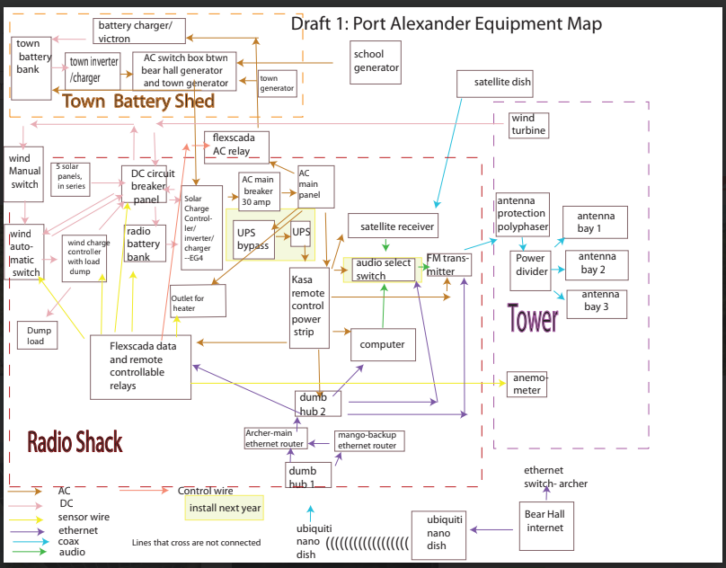
No watts to spare
One of the biggest obstacles in these villages is electric power. In Port Alexander, all power comes from personal generators, except for a generator that powers city hall (known as Bear Hall for the large animal skin hanging on the wall).
We wanted to replace this transmitter with a new one and go from 10 watts to our full 250-watt power. The city has just a small, underperforming battery bank and couldn’t spare that much power for a 24/7 load and still power Bear Hall.
Port Alexander receives a diesel delivery once a year, by a single fuel barge. Prices are high, generators are loud and can be unreliable, and everyone is acutely aware of the precariousness of where their energy comes from. It we wanted to update the Port Alexander translator, we’d need power generation and storage.
It was a happy circumstance for me. Becoming a wind and solar installer had been my career plan when I went to college in the early ’90s. During the first Gulf War, I studied solar energy in the hope of helping to prevent such wars. Sadly, by the time I graduated, the war supposedly had been won and the solar industry was moribund for the next 15 years. Needless to say, future oil wars were not avoided either.
I worked for a few months in solar in New Mexico but changed careers to radio engineering; I now run a one-man non-profit radio engineering outfit, the Center for International Media Action. I’d been hoping for an opportunity to catch up on the exciting developments in solar, particularly off-grid style projects.
Solar … in Alaska?
Although solar is not the thing most people think of when they think of Alaska, there is a substantial resource. In KCAW’s listening area in southeast coastal Alaska, the climate is less ice and snow, and more like a harsher version of the Pacific Northwest — rainy, high winds, lots of fog, but proximity to the ocean means that the temperature seldom stays below freezing long.
Though that doesn’t sound good for solar, the time of year we need the most power is summer, to reach all those fishing boats. In summer, days are quite long! While I was there in August, first light was around 4:30 a.m. and it did not get dark until 9:30 p.m., so in the same way vegetables grow so big further north, there can be quite a bit of sun when you need it most.
For solar panels, we went with a panel from CanadianSolar … five panels, 400 watts each. These have an interesting new feature. The cells are exposed in the back of the panel, and the manufacturer claims that in good sun you can get 10% to 40% extra power from reflected sunlight shining on the underside of them! They were around the same price as other panels, so we gave them a try.
Unfortunately, we weren’t really able to test out the product claim, given that our site has heavy vegetation on the ground. This panel would be more appropriate on a roof painted white or silver coated.
Our site in Port Alexander had real challenges for solar. It is a small site, on a ridge, but the only semi-logical place for the panels was in a bit of a clearing we cut from dense brush in front of the satellite dish. It is about four to eight feet lower than some of the land around it.
Much of the “ground” consists of old fallen trees that have been decaying for decades. There were also so many trees nearby. We cut some, but others are rooted into the side of the ridge and impossible to cut safely.
So our site in summer gets reasonable sun from around 11 a.m. until 6 p.m. Clearer surroundings would definitely have gotten us more hours of sun on the panels.
One thing that I observed was that even on mildly overcast days, the 2 kW array could put out 500 to 600 watts. I was encouraged that even in bad conditions, this system could provide at least enough to take care of its own overhead.
Also, we wired all the panels in series. Modern charge controller manufacturers have moved in the direction of accepting higher voltages, lower amperages and panels in long strings with thinner copper wires between them. This has brought prices down dramatically.
The Achilles heel is when you get shading on some of the panels in the long string. Your output suffers more when you have one panel partially shaded in a series string than if you had one panel shaded but everything else at full output in parallel. In a future visit, I may choose to break up the single string of five panels into two strings of two and three, because three of the panels are relatively unshaded, while two are in a more problematic spot closer to the shadows of the trees.
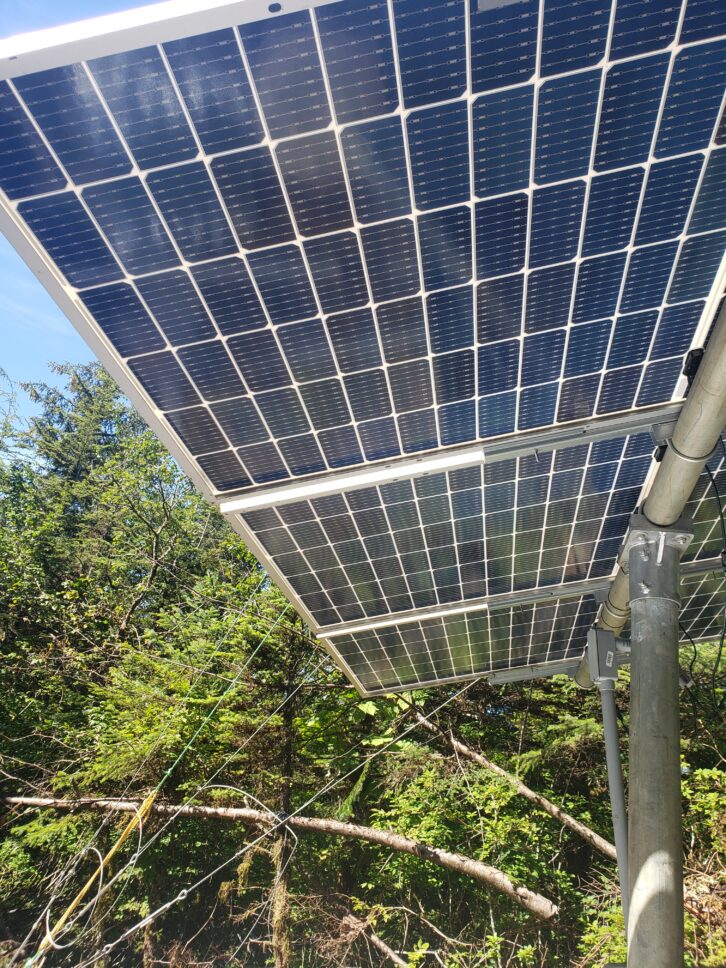
Turbine considerations
Wind is, in general, a trickier and more subtle resource than solar.
There are a zillion companies that make small cheap windmills, mostly for boats. What I have learned is that it is quite easy to make a windmill that makes electricity; what is hard is manufacturing one that can survive occasional high winds. Since this area regularly has extremely high winds in the winter, we had to make a careful selection of the windmill we would try installing.
The wind industry, sadly, has somewhat of a bad reputation for hucksterism. For some reason, small wind attracts the same crowd as bogus perpetual motion machines. “Energy … Free … From the Air!!!”
There are a lot of small cheap wind turbines but they have a tendency to blow apart in the first bad storm. There are also many “artsy” turbines that look like something out of an episode of “The Jetsons.” Unfortunately, most of these don’t produce much energy, they are more of an eco-status symbol than a practical energy technology.
When shopping for a wind turbine don’t dwell on the manufacturer’s power rating in watts. In the U.S. (and on the internet), there is no standardization for how claims of wattage output are made. Among small cheap turbines, there is generally a race to the bottom, with companies highballing their claimed output wattage, which has almost no relationship to its realistic output.
There is relatively little difference between decent brands in the amount of electricity they can produce from a given swept area of turbine blades. There is no getting around the physical theoretical maximum amount of energy that can be obtained from a given windspeed and swept area. Most reputable manufacturers provide pretty similar performance.
A better parameter to look at than watts or exotic blade designs is straightforward: the swept area of the rotor blades. You can confirm the product claim easily enough with a ruler when you take it out of the box!
The first approximation in planning is to look up the average wind speed per year in your area from charts provided by the National Renewable Energies Laboratory, or NREL.
Most reputable manufacturers have simple curves that show how many kilowatt hours per year you can expect, given the average windspeed at your site. For large projects, there is no substitute for a year or two of measurements with an anemometer at the exact height and location that you intend to build. A location may be windy, but because of local obstructions, much of the wind is turbulence, which will buffet the turbine without producing a lot of useful electricity.
Later in the planning process, I used historical monthly average windspeeds and insolation data from NREL to approximate the kilowatt hours available month by month of both the wind and solar contributions.
Generally speaking, the best wind turbines are the simplest, with two or three blades on a horizontal axis. While there have been a few vertical axis windmills that have run reliably and produced energy, there are several practical problems that have led to a long history of premature failures of vertical wind machines.
The turbine we chose
We opted for one of the most expensive in the class of very small wind turbines, from Mission Critical Energy. They market a German-made turbine, Superwind, in the U.S.
They had a very interesting spring-loaded furling technology. This method contracts the surface area of the blades during high winds, so as winds go up, less surface area faces them and the destructive forces are controlled.
European wind is a more mature industry than we have in the U.S., with greater regulation and higher standards. Since many neighborhoods have small wind turbines nearby, nothing is allowed on the market if it is found to be too noisy or to cause other troubles.
Mission Critical also offered FlexSCADA, a SCADA technology interface and an automatic cut-off switch. We were able to install an anemometer connected to the SCADA computer. If winds reach over 70 miles an hour, FlexSCADA throws a relay, shorting the leads coming from the turbine, acting as a brake. Also, if the SCADA detects more than 7.75 amps coming from the turbine, that can also throw the relay and stop the turbine, protecting it from blowing itself apart.
Obviously, we had no way to test this in the quiet winds of summer, but we should be able to observe it remotely by the SCADA interface and see if it is working as intended during big windstorms.
Programming the SCADA required a significant learning curve. SCADA uses JavaScript to create commands that will implement functions such as “if amperage of sensor 6032 exceeds 7.75 amp, throw relay #4.”
I admit that I got worried when the company gave me a little sample code and encouraged me to “play around with it.” I don’t know the first thing about JavaScript. And this code was what would stop the windmill from ripping itself apart in gale-force winds!
However, we did fool around with it. Then I wrote up a detailed description of our needs, and I made a newbie attempt at writing it up in Java. Then two programmers at Mission Critical looked it over, corrected it and we tested it together over Zoom, checking that amperages read correctly, wind was measured in correct units, relays would fire when voltage thresholds were crossed, etc. I was impressed with their support.
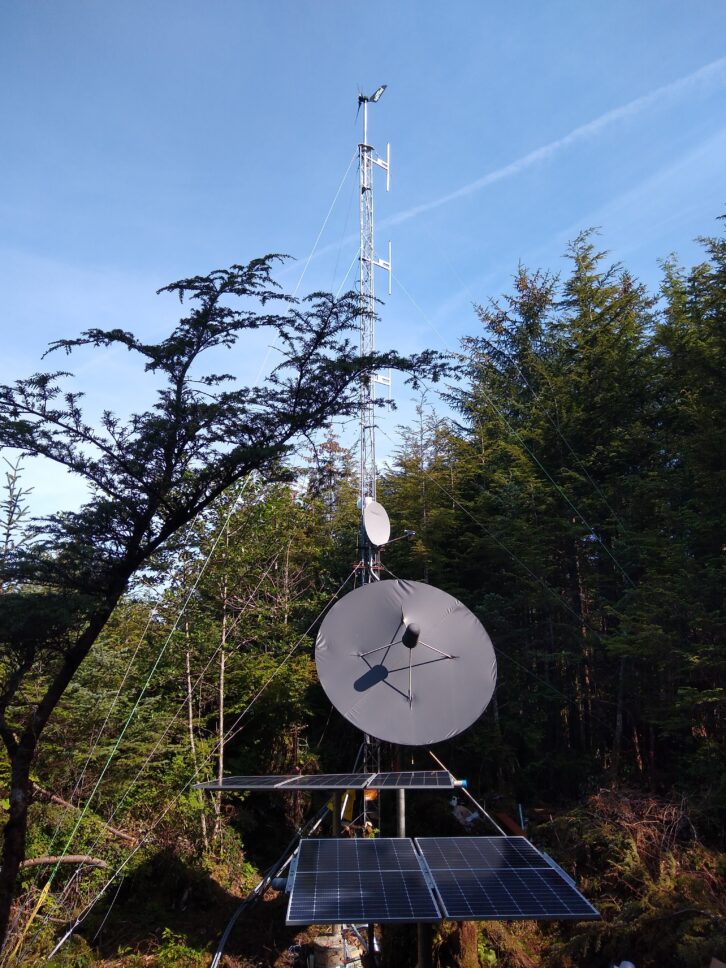
Batteries, charge controllers, inverters
Lithium-ion batteries are finally starting to beat lead-acid batteries on the long-term cost of a system. They are, of course, still more expensive but can be expected to last considerably longer, with deeper usable cycling and less maintenance. There are many being made now, and we still need some time to shake out reputable manufacturers from fly-by-night operations.
I chose the EG4-LiFePower batteries because the price was excellent and the support is here in the U.S., from Signature Solar, even though the batteries, like most these days, are manufactured in China. Before shipping, we paid about $7,000 for a 19.2 kWH system.
One thing that has changed since the days of my work in solar has been the integration of system functions in a single box. Whereas battery chargers, charge controllers and inverters were all separate system parts when I worked in solar, I chose the EG4 as a one-box solution for all three functions. It integrates nicely with the rack-mounted EG4 batteries.
Ethernet cables connect the battery management systems of the batteries and the inverter/charger/charge controller. This is compact and saves a lot of trouble during installation. It is an impressive piece of equipment at a great price.
Installation could not have been easier, except for two issues. First: The device has a fairly high overhead in power consumption, about 65 watts of constant load all the time, even if you are only using a few watts. (It only consumes this when it is inverting, not when it is charging or charge-controlling.) That is about 1.5 kWH per day you have to produce just to feed the inverter/charger/controller.
Second: The app that comes with it was atrocious. Despite the connectivity of the device, there is no browser-based GUI that can control it. You can only use an app. There are two, and it is unclear which is better for what purpose. Neither could do the main thing that they are supposed to do: connect the wireless data logger and control to the local Wi-Fi network.
With the surge of interest in solar, Signature Solar tech support has been caught flat-footed. I was surprised, because in the spring when I installed a different system, tech support was knowledgeable and responsive. In August I had the exact opposite experience. I’ll spare you the details, but after well over 30 hours of effort, I never was able to get the app to connect the inverter to the internet, so even now I have no remote control or monitoring over that part of the system.
While I was disappointed by the app and lack of support, this is widespread in the solar industry. It has many small-time operators who are suddenly juggling more work and bigger projects than they can handle. Some will grow to meet the challenge, others will fall off or narrow their specialties.
There is considerable “greenflation.” Even as devices are getting cheaper, professional-level labor and tech support is getting more expensive as demand increases. It will take time for the industry to catch up with its success. In addition, supply chain issues throughout all industries mean that projects need longer purchasing and shipping lead times than we have become accustomed to.
One fortunate thing about this project is that the town does regularly run its big generator, and it can’t safely run without a large load. Sometimes, they have to run big sodium vapor lights when all they want to do is power up the internet. The town has a battery bank, but it has some serious performance issues and runs down fairly quickly, even under a small load, under 100 watts. So our new large radio battery bank is a benefit to the town, a large sink for power that will be usable later.
We set up the FlexSCADA to throw a relay that will send 10 amps to the town bank whenever our bank goes above 53 volts. And we have the benefit of a bunch of extra charge from their generator to supplement the wind and solar.
The battery bank, by itself, should be able to carry us through roughly four days, even with no charge coming in from the wind, solar or the town. The wind contribution will be small, since it is a small turbine, but significant in fall, winter and spring. The solar will handle most of our demand through the summer, and much in spring and fall. Hopefully we’ll be able to help them run their generator less often for the modest needs of town hall, and use the power they do produce more efficiently.
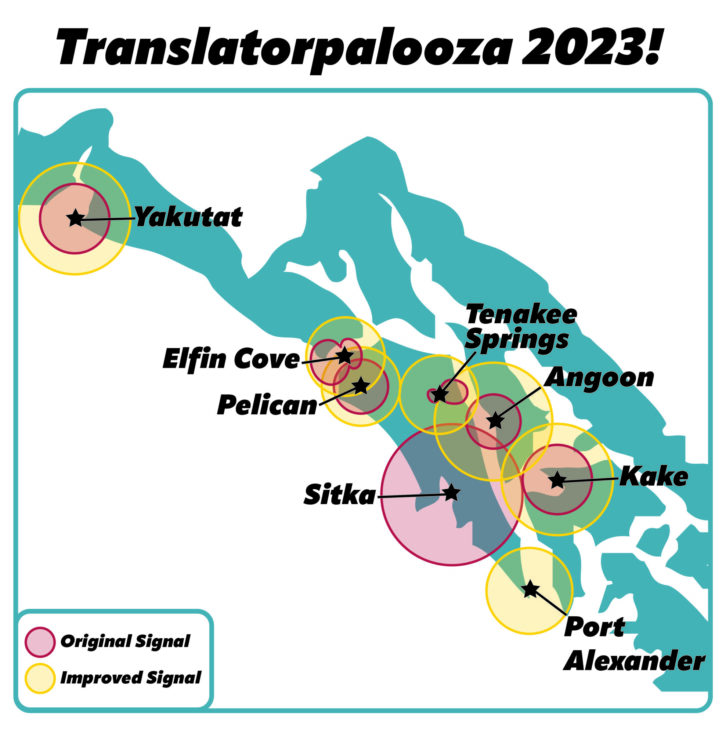
An off-grid approach to antennas
The initial configuration was 10 watts with a directional antenna. Our goal was 250 watts omnidirectional. I would normally put in a one- or two-bay, circularly polarized antenna; the FCC only counts the horizontal watts, so that you can put considerably more watts in the air with circular polarization. Where electricity is cheap and effectively infinite, this is a good strategy for getting the most allowable coverage.
However, we were limited by electric power input; we did not have electrical watts to spare, so I opted for a three-bay vertical dipole from Label Italy. This allowed me to have some gain and reduce TPO in order to get a 250-watt equivalent ERP.
The antenna installation went well, with low SWR. The price was competitive, the lead time from Italy was not bad, the construction was solid, and everything about it struck me as on par with American antennas at twice the price.
The downside with a three-bay is that it requires more tower space than we had available. The existing tower was a Rohn 25G, 37 feet tall with a seven-foot tapered top section. We had to replace that top section with one that could support a pole for the windmill, so we removed the top and then added three seven-foot (UPS shippable) Rohn sections plus a pole, bringing the windmill to roughly 56 feet.
Transmitter choice
We chose an Ecreso transmitter, which has internet-based diagnostic functionality. I also am intrigued by the technology called SmartFM. Essentially, it turns down the RF power when there is highly dense program material, because if it is done carefully, the listenability and coverage can remain indistinguishable. The manufacturer says that power savings can be up to 40% of what you would normally have to use, with equivalent coverage.
This feature is available in their new transmitters but has not been approved by the FCC at last check, so we are hoping for an experimental authorization to switch it on. We look forward to trying it out.
The Future
The Port Alexander project was the first in a series of seven projects we will do to modernize the KCAW translator system. We were fortunate in this first project to have the interaction with the town hall generator and battery bank to make both systems more efficient. We’ll do similar systems at each of the towns, so that our station can be more reliable during emergencies and self-sufficient as well.
This summer I am doing “triage,” replacing transmitters and scoping for full rebuilds in Tenakee Springs, Pelican and Elfin Cove. In the summer of 2024, we will do somewhat larger towns: Kake and Angoon, with populations closer to 600. I will likely take on an intern or two for summer of 2024, so pass this article on to anyone you know with a free summer, a desire to escape the heat waves of the lower 48 and an interest in broadcast engineering and alternative energy sources. You can hear a story that KCAW reporter Tash Kimmell reported at this site, and see more photos of Port Alexander.


